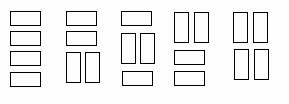- 换零钱问题(dp问题)
cx_2023
算法动态规划
大面值纸币换成小面值纸币问题,dp问题将amount换成coins数组中的小面值零钱,求最少换成多少张#include#includeusingnamespacestd;typedeflonglongll;constllN=1e5+10;intmain(){//大面值纸币换成小面值纸币问题,dp问题//将amount换成coins数组中的小面值零钱,求最少换成多少张llamount;//初始钱的大
- 服务器如何配置防火墙规则开放/关闭端口?
莱卡云(Lcayun)
服务器云计算linux安全
配置服务器防火墙规则(开放/关闭端口)是服务器安全管理的基础操作,不同操作系统和防火墙工具的配置方式有所不同。以下是主流系统的详细操作指南:一、Linux系统(iptables/firewalld/UFW)1.iptables(传统方式)#查看当前规则sudoiptables-L-n#开放端口(如80/TCP)sudoiptables-AINPUT-ptcp--dport80-jACCEPT#关闭
- 【Zephyr开发实践系列】02_MPU6050极简驱动设计(轮询模式)
jz-炸芯片的zero
Zephyr实践开发单片机物联网嵌入式硬件驱动开发iotlinuxstm32
文章目录前言一、MPU6050驱动模型1.1核心应用API(必须)1.2设置数据结构1.3硬件初始化1.4设备实例化二、数据结构定义2.1寄存器相关配置2.2陀螺仪灵敏度值2.2数据结构Data配置结构三、核心功能实现3.1原数据解算3.2通道数据获取3.3采样数据获取3.4初始化总结前言在传统嵌入式传感器开发中,裸机驱动往往需要数百行初始化代码,而复杂的RTOS驱动又面临框架学习成本高的问题。Z
- 【ubuntu】如何构建自己的ubuntu内核
1.准备环境sudoaptupdatesudoaptinstallbuild-essentialfakerootdpkg-devkernel-packagelibncurses-devbisonflexlibssl-devlibelf-dev2.下载内核源码确认源码包,下载源码包。dpkg-S/boot/vmlinuz-$(uname-r)linux-image-5.15.0-46-generic
- LogisticRegression(solver = ‘lbfgs‘)的ConvergenceWarning问题解决
Love And Program
废掉小脑阔的错误pythonscikit-learn
一个帅气的boy,你可以叫我LoveAndProgram⌨个人主页:LoveAndProgram的个人主页如果对你有帮助的话希望三连支持一下博主LogisticRegression的ConvergenceWarning问题解决,收敛警告,意义为未完全收敛问题解决方法问题在执行LogisticRegression(solver=‘lbfgs’)时出现如下错误:ConvergenceWarning:l
- 强化学习:Deep Deterministic Policy Gradient (DDPG) 学习笔记
烨川南
强化学习学习笔记算法人工智能机器学习
一、DDPG是什么?1.1核心概念DDPG=Deep+Deterministic+PolicyGradientDeep:使用深度神经网络和类似DQN的技术(经验回放、目标网络)Deterministic:输出确定的动作(而不是概率分布)PolicyGradient:基于策略梯度的方法,优化策略以最大化累积奖励1.2算法特点特性说明连续动作空间直接输出连续动作值(如方向盘角度、机器人关节扭矩)离线学
- ESP32+Arduino IDE+PWM呼吸灯/舵机
AAA五金机电
idec++pythonvscode单片机物联网
前言pwm在单片机里的应用还是很广泛滴,包括呼吸灯、电机、舵机等等,大一做校电赛的时候没搞懂pwm,一直念念不忘,最近认真学了一下感觉还是挺简单滴!有一些电路基础知识就可以很快掌握了。PWM基本原理PWM:全称PulseWidthModulation:脉冲宽度调制(简称脉宽调制,通俗的讲就是调节脉冲的宽度),是电子电力应用中非常重要的一种控制技术。PWM频率:是指一秒钟内从高电平时间在到低电平时间
- BM2 链表内指定区间反转
目录题目链接题目解题思路代码题目链接链表内指定区间反转_牛客题霸_牛客网题目解题思路只是比第一题多了一个范围,有两个思路一:先移动到要逆序的位置前一个固定,然后逐个往后移动并且讲当前位置的指针移动到固定位置的相邻就近的后面即可二:拼接的方法,截图前面不需要逆序的,中间的调用逆序方法,截取后面需要逆序的最后拼接即可代码法一importjava.util.*;/**publicclassListNod
- leetcode动态规划—子序列系列
刷完之后,写的总结经验1、首先是子序列问题、子串问题、子数组问题,一定要搞清楚dp数组里是否是严格结尾2、其次是dp数组的定义,可以为了方便初始化而特殊处理定义一下lc300最长递增子序列初始化为1而非0,因为最长递增子序列最短为1无需连续,则可以从前面任意字串尾部续上,需要遍历以【0】-【i-1】为结尾的字串最后输出的是dp[0]~dp[n-1]中的最大值classSolution:deflen
- 数据结构(Java)--位运算
老虎0627
数据结构数据结构java开发语言
前言本文为本小白学习数据结构的笔记,将以算法题为导向,向大家更清晰的介绍数据结构相关知识(算法题都出自B站马士兵教育——左老师的课程,讲的很好,对于想入门刷题的人很有帮助)为什么要使用为位运算位运算直接对整数的二进制位进行操作,因为在计算机中数据都是以二进制存储的,因此它在许多场景下能够提供比传统算术和逻辑运算更高效、更简洁的解决方案。常见的几种位运算1.位与&十进制转二进制两个都为1则为1,否则
- 测试第六讲-测试模型&分类
为你奋斗!
测试用例经验分享
一、软件测试的模型1、软件测试模型表达的是测试阶段和开发阶段的对应关系2、V模型(重点)(1)会画v模型(2)优、缺点优点:1)软件的开发阶段和测试阶段(级别)划分明确,对应关系明确2)测试阶段既包含单元测试(专业级,代码级),也包含验收测试(用户级)缺点:缺少需求分析阶段和设计阶段的测试过程,容易造成误解,测试只是开发后的收尾工作,没能体现出尽早测试原则和不断测试原则(开发与测试是同步进行的工作
- FastAPI Filter 项目教程
FastAPIFilter项目教程fastapi-filterFilterandorderyourendpoints项目地址:https://gitcode.com/gh_mirrors/fa/fastapi-filter1.项目的目录结构及介绍FastAPIFilter项目的目录结构如下:fastapi-filter/├──README.md├──fastapi_filter/│├──__ini
- 动手实践:如何提取Python代码中的字符串变量的值
大千AI助手
人工智能Python#DeepSeekpython开发语言人工智能deepseekAST
要提取Python代码中所有变量类型为字符串的变量的值,但不执行代码(避免安全风险),可以通过静态分析代码的抽象语法树(AST)来实现。以下是完整的解决方案:本文由「大千AI助手」原创发布,专注用真话讲AI,回归技术本质。拒绝神话或妖魔化。搜索「大千AI助手」关注我,一起撕掉过度包装,学习真实的AI技术!往期文章推荐:20.条件概率:不确定性决策的基石19.深度解读概率与证据权重-Probabil
- 电子电气诊断架构 --- HPC车载诊断
汽车电子实验室
车载电子电气架构漫谈UDS诊断协议系列架构
我是穿拖鞋的汉子,魔都中坚持长期主义的汽车电子工程师。老规矩,分享一段喜欢的文字,避免自己成为高知识低文化的工程师:做到欲望极简,了解自己的真实欲望,不受外在潮流的影响,不盲从,不跟风。把自己的精力全部用在自己。一是去掉多余,凡事找规律,基础是诚信;二是系统思考、大胆设计、小心求证;三是“一张纸制度”,也就是无论多么复杂的工作内容,要在一张纸上描述清楚;四是要坚决反对虎头蛇尾,反对繁文缛节,反对老
- 电子电气架构 --- 涵盖“诊断与 ECU 平台”领域特有项目要求(上)
汽车电子实验室
车载电子电气架构车载电子与软件框架电子电器架构开发流程架构HPC软件架构ZEVonUDS-J1979车载通信网络槪述汽车
我是穿拖鞋的汉子,魔都中坚持长期主义的汽车电子工程师。老规矩,分享一段喜欢的文字,避免自己成为高知识低文化的工程师:做到欲望极简,了解自己的真实欲望,不受外在潮流的影响,不盲从,不跟风。把自己的精力全部用在自己。一是去掉多余,凡事找规律,基础是诚信;二是系统思考、大胆设计、小心求证;三是“一张纸制度”,也就是无论多么复杂的工作内容,要在一张纸上描述清楚;四是要坚决反对虎头蛇尾,反对繁文缛节,反对老
- 车载电子电气架构 --- 从车窗演进看车联网的需求、发展与选择
汽车电子实验室
思考车载总线类型架构分布式电子电气架构网络协议实时系统评价的概述职场和发展
我是穿拖鞋的汉子,魔都中坚持长期主义的汽车电子工程师。老规矩,分享一段喜欢的文字,避免自己成为高知识低文化的工程师:做到欲望极简,了解自己的真实欲望,不受外在潮流的影响,不盲从,不跟风。把自己的精力全部用在自己。一是去掉多余,凡事找规律,基础是诚信;二是系统思考、大胆设计、小心求证;三是“一张纸制度”,也就是无论多么复杂的工作内容,要在一张纸上描述清楚;四是要坚决反对虎头蛇尾,反对繁文缛节,反对老
- 车载软件架构 --- SOC具备安卓系统ECU完整启动流程
汽车电子实验室
车辆信息安全汽车行业androidECU完整启动流程SOC具备安卓系统c++
我是穿拖鞋的汉子,魔都中坚持长期主义的汽车电子工程师。老规矩,分享一段喜欢的文字,避免自己成为高知识低文化的工程师:周末洗了一个澡,换了一身衣服,出了门却不知道去哪儿,不知道去找谁,漫无目的走着,大概这就是成年人最深的孤独吧!旧人不知我近况,新人不知我过往,近况不该旧人知,过往不与新人讲。纵你阅人何其多,再无一人恰似我。时间不知不觉中,来到新的一年。2025开始新的忙碌。成年人的我也不知道去哪里渡
- 车载诊断架构 --- 经典ECU的基石与未来系统的挑战
我是穿拖鞋的汉子,魔都中坚持长期主义的汽车电子工程师。老规矩,分享一段喜欢的文字,避免自己成为高知识低文化的工程师:做到欲望极简,了解自己的真实欲望,不受外在潮流的影响,不盲从,不跟风。把自己的精力全部用在自己。一是去掉多余,凡事找规律,基础是诚信;二是系统思考、大胆设计、小心求证;三是“一张纸制度”,也就是无论多么复杂的工作内容,要在一张纸上描述清楚;四是要坚决反对虎头蛇尾,反对繁文缛节,反对老
- 蒙特卡洛方法:随机抽样的艺术与科学
大千AI助手
人工智能Python#OTHER机器学习人工智能贝叶斯概率蒙特卡洛随机
本文由「大千AI助手」原创发布,专注用真话讲AI,回归技术本质。拒绝神话或妖魔化。搜索「大千AI助手」关注我,一起撕掉过度包装,学习真实的AI技术!蒙特卡洛算法(MonteCarloMethod)是一类基于随机抽样解决确定性问题的计算方法,其核心思想是:通过大量随机实验的统计结果逼近复杂数学问题的解。它得名于摩纳哥的蒙特卡洛赌城(象征随机性),由冯·诺依曼、乌拉姆等科学家在曼哈顿计划中首次系统化应
- 你确定懂冒泡排序?用动画的方式讲懂冒泡排序及其优化方式
linwu-hi
动画解析数据结构和算法前端算法排序算法
点击在线阅读,体验更好链接现代JavaScript高级小册链接深入浅出Dart链接现代TypeScript高级小册链接基本概念冒泡排序是一种基础的排序算法。其基本思想是通过不断地比较相邻元素并在必要时进行交换,将最大(或最小)的元素"冒"到序列的一端。排序步骤先来感受到冒泡排序的步骤吧以数组[5,3,8,4,6]为例,冒泡排序的步骤如下:第一轮排序:比较相邻的元素。第一次比较5和3,5大于3,交换
- DeepSpeed zero1,zero2,zero3和FSDP区别详解
ALGORITHM LOL
python分布式
1.基本概念DeepSpeedZeROZeRO是由MicrosoftDeepSpeed团队开发的一种内存优化技术,旨在通过分片模型状态来训练超大模型,减少每个GPU的内存占用,同时避免传统模型并行(如张量并行或流水线并行)所需的代码修改。ZeRO分为三个阶段(Stage1、Stage2、Stage3),每阶段逐步增加分片的范围,从而进一步降低内存需求。FSDP(FullyShardedDataPa
- java 线程状态 和 线程池状态
@ chen
Java基础java
在Java中,线程状态(ThreadState)和线程池状态(ThreadPoolState)是两个不同维度的概念。下面分别详细说明:一、Java线程状态(Thread.State)Java线程状态定义在java.lang.Thread.State枚举中,共6种状态:状态说明NEW线程已创建但未启动(未调用start()方法)。RUNNABLE线程正在运行或等待操作系统资源(如CPU)。包含两个子
- Linux之Socket 编程 UDP
孞㐑¥
linuxudp经验分享笔记c++服务器网络协议
一、UDP网络编程1.1、V1版本-echoserver功能:简单的回显服务器和客户端代码注意:云服务器不允许直接bind公有IP,我们也不推荐编写服务器的时候,bind明确的IP,推荐直接写成INADDR_ANY。C++/*Addresstoacceptanyincomingmessages.*/#defineINADDR_ANY((in_addr_t)0x00000000)在网络编程中,当一个
- 使用Puppeteer抓取动态网页的完整指南
当遇到React/Vue等现代前端框架构建的SPA(单页应用)时,传统爬虫无法获取JavaScript动态渲染的内容。本文将教你使用Puppeteer破解这个难题,实现真正的动态网页抓取。我们开始准备环境1.安装Node.js版本至少要在14以上才行哦2.初始化开发项目的命令在这里mkdirpuppeteer-crawler&&cdpuppeteer-crawlernpminit-y3.在项目里边
- 2025年iptables防御DDoS攻击终极指南:从原理到实战配置
上海云盾商务经理杨杨
ddos
一、DDoS攻击新趋势与iptables的防御定位1.2025年攻击特征升级AI驱动的自适应攻击:攻击流量动态模拟合法用户行为,传统规则引擎漏检率超40%。混合攻击常态化:SYNFlood、UDPFlood、CC攻击组合使用(如SYN+HTTPFlood),单次攻击峰值突破8Tbps。IPv6协议滥用:利用IPv6多播地址扫描内网,绕过传统IPv4防护规则。2.iptables的核心优势轻量级内核
- 计算机考研408真题解析(2024-39 UDP校验和算法深度解析)
【良师408】计算机考研408真题解析(2024-39UDP校验和算法深度解析)传播知识,做懂学生的好老师1.【哔哩哔哩】(良师408)2.【抖音】(良师408)goodteacher4083.【小红书】(良师408)4.【CSDN】(良师408)goodteacher4085.【微信】(良师408)goodteacher408特别提醒:【良师408】所收录真题根据考生回忆整理,命题版权归属教育部
- autosize px转dp_Android屏幕适配-应用篇
weixin_39676633
autosizepx转dp
目录Android屏幕适配最主要的原因:是由于Android手机的分辨率和尺寸千奇百怪,虽然Android官方提供了dp单位来适配,但其在各种奇怪分辨率下表现却不尽如人意。主要是由于在界面在渲染绘制时,android会将dp转为px,在转换过程中是需要dpi的(上篇文章中有提到),而dpi是根据屏幕真实的分辨率和尺寸来计算的,每个设备都可能不一样的,从而导致显示问题。从两个大方面阐述一下Andro
- autosize px转dp_Android屏幕适配实例教程「今日头条,AutoSize」
weixin_39683526
autosizepx转dp
Android屏幕适配实例教程即使只是练习项目,仍然要使用屏幕适配,这样我们就可以跟着设计图上的单位参数敲,效率会快很多项目的示范代码使用kt语言,但没有用到什么高级特性,完全不懂的参考这个链接,文章参考代码已经上传到Github,本篇相关的设计图链接戳这里这里提供一个App的UI设计图小白日记,仅供参考前期与UI之间的沟通1)确定设计图基准=可以简单理解为以某个尺寸为基准,然后通过改变对应的比例
- MySQL数据库的优化技巧:数据合规
数据库管理艺术
数据库mysqlai
从性能到合规:MySQL数据库的双向优化实战指南关键词数据合规、MySQL优化、GDPR、数据脱敏、审计日志、访问控制、数据生命周期摘要在数据安全法规(如GDPR、《个人信息保护法》)日益严格的今天,企业数据库不仅要追求高性能,更需满足合规要求。本文将结合MySQL的实际场景,拆解"性能优化"与"数据合规"的协同路径,通过生活化比喻、代码示例和真实案例,帮助DBA、开发人员掌握从数据分类到脱敏、从
- ReactNative进阶(四十四):Mobile App 适配性优化_react native 适配
在ReactNative中尺寸是没有单位的,它代表了设备独立像素。尺寸上述代码,运行在Android上时,View的长和宽被解释成:100dp100dp单位是dp,字体被解释成16sp单位是sp,运行在iOS上时尺寸单位被解释称了pt,这些单位确保了布局在任何不同dpi的手机屏幕上显示不会发生改变;值得一提的是,ReactNative中的FlexBox和WebCSS上FlexBox工作方式是一样的
- ztree设置禁用节点
3213213333332132
JavaScriptztreejsonsetDisabledNodeAjax
ztree设置禁用节点的时候注意,当使用ajax后台请求数据,必须要设置为同步获取数据,否者会获取不到节点对象,导致设置禁用没有效果。
$(function(){
showTree();
setDisabledNode();
});
- JVM patch by Taobao
bookjovi
javaHotSpot
在网上无意中看到淘宝提交的hotspot patch,共四个,有意思,记录一下。
7050685:jsdbproc64.sh has a typo in the package name
7058036:FieldsAllocationStyle=2 does not work in 32-bit VM
7060619:C1 should respect inline and
- 将session存储到数据库中
dcj3sjt126com
sqlPHPsession
CREATE TABLE sessions (
id CHAR(32) NOT NULL,
data TEXT,
last_accessed TIMESTAMP NOT NULL,
PRIMARY KEY (id)
);
<?php
/**
* Created by PhpStorm.
* User: michaeldu
* Date
- Vector
171815164
vector
public Vector<CartProduct> delCart(Vector<CartProduct> cart, String id) {
for (int i = 0; i < cart.size(); i++) {
if (cart.get(i).getId().equals(id)) {
cart.remove(i);
- 各连接池配置参数比较
g21121
连接池
排版真心费劲,大家凑合看下吧,见谅~
Druid
DBCP
C3P0
Proxool
数据库用户名称 Username Username User
数据库密码 Password Password Password
驱动名
- [简单]mybatis insert语句添加动态字段
53873039oycg
mybatis
mysql数据库,id自增,配置如下:
<insert id="saveTestTb" useGeneratedKeys="true" keyProperty="id"
parameterType=&
- struts2拦截器配置
云端月影
struts2拦截器
struts2拦截器interceptor的三种配置方法
方法1. 普通配置法
<struts>
<package name="struts2" extends="struts-default">
&
- IE中页面不居中,火狐谷歌等正常
aijuans
IE中页面不居中
问题是首页在火狐、谷歌、所有IE中正常显示,列表页的页面在火狐谷歌中正常,在IE6、7、8中都不中,觉得可能那个地方设置的让IE系列都不认识,仔细查看后发现,列表页中没写HTML模板部分没有添加DTD定义,就是<!DOCTYPE html PUBLIC "-//W3C//DTD XHTML 1.0 Transitional//EN" "http://www.w3
- String,int,Integer,char 几个类型常见转换
antonyup_2006
htmlsql.net
如何将字串 String 转换成整数 int?
int i = Integer.valueOf(my_str).intValue();
int i=Integer.parseInt(str);
如何将字串 String 转换成Integer ?
Integer integer=Integer.valueOf(str);
如何将整数 int 转换成字串 String ?
1.
- PL/SQL的游标类型
百合不是茶
显示游标(静态游标)隐式游标游标的更新和删除%rowtyperef游标(动态游标)
游标是oracle中的一个结果集,用于存放查询的结果;
PL/SQL中游标的声明;
1,声明游标
2,打开游标(默认是关闭的);
3,提取数据
4,关闭游标
注意的要点:游标必须声明在declare中,使用open打开游标,fetch取游标中的数据,close关闭游标
隐式游标:主要是对DML数据的操作隐
- JUnit4中@AfterClass @BeforeClass @after @before的区别对比
bijian1013
JUnit4单元测试
一.基础知识
JUnit4使用Java5中的注解(annotation),以下是JUnit4常用的几个annotation: @Before:初始化方法 对于每一个测试方法都要执行一次(注意与BeforeClass区别,后者是对于所有方法执行一次)@After:释放资源 对于每一个测试方法都要执行一次(注意与AfterClass区别,后者是对于所有方法执行一次
- 精通Oracle10编程SQL(12)开发包
bijian1013
oracle数据库plsql
/*
*开发包
*包用于逻辑组合相关的PL/SQL类型(例如TABLE类型和RECORD类型)、PL/SQL项(例如游标和游标变量)和PL/SQL子程序(例如过程和函数)
*/
--包用于逻辑组合相关的PL/SQL类型、项和子程序,它由包规范和包体两部分组成
--建立包规范:包规范实际是包与应用程序之间的接口,它用于定义包的公用组件,包括常量、变量、游标、过程和函数等
--在包规
- 【EhCache二】ehcache.xml配置详解
bit1129
ehcache.xml
在ehcache官网上找了多次,终于找到ehcache.xml配置元素和属性的含义说明文档了,这个文档包含在ehcache.xml的注释中!
ehcache.xml : http://ehcache.org/ehcache.xml
ehcache.xsd : http://ehcache.org/ehcache.xsd
ehcache配置文件的根元素是ehcahe
ehcac
- java.lang.ClassNotFoundException: org.springframework.web.context.ContextLoaderL
白糖_
javaeclipsespringtomcatWeb
今天学习spring+cxf的时候遇到一个问题:在web.xml中配置了spring的上下文监听器:
<listener>
<listener-class>org.springframework.web.context.ContextLoaderListener</listener-class>
</listener>
随后启动
- angular.element
boyitech
AngularJSAngularJS APIangular.element
angular.element
描述: 包裹着一部分DOM element或者是HTML字符串,把它作为一个jQuery元素来处理。(类似于jQuery的选择器啦) 如果jQuery被引入了,则angular.element就可以看作是jQuery选择器,选择的对象可以使用jQuery的函数;如果jQuery不可用,angular.e
- java-给定两个已排序序列,找出共同的元素。
bylijinnan
java
import java.util.ArrayList;
import java.util.Arrays;
import java.util.List;
public class CommonItemInTwoSortedArray {
/**
* 题目:给定两个已排序序列,找出共同的元素。
* 1.定义两个指针分别指向序列的开始。
* 如果指向的两个元素
- sftp 异常,有遇到的吗?求解
Chen.H
javajcraftauthjschjschexception
com.jcraft.jsch.JSchException: Auth cancel
at com.jcraft.jsch.Session.connect(Session.java:460)
at com.jcraft.jsch.Session.connect(Session.java:154)
at cn.vivame.util.ftp.SftpServerAccess.connec
- [生物智能与人工智能]神经元中的电化学结构代表什么?
comsci
人工智能
我这里做一个大胆的猜想,生物神经网络中的神经元中包含着一些化学和类似电路的结构,这些结构通常用来扮演类似我们在拓扑分析系统中的节点嵌入方程一样,使得我们的神经网络产生智能判断的能力,而这些嵌入到节点中的方程同时也扮演着"经验"的角色....
我们可以尝试一下...在某些神经
- 通过LAC和CID获取经纬度信息
dai_lm
laccid
方法1:
用浏览器打开http://www.minigps.net/cellsearch.html,然后输入lac和cid信息(mcc和mnc可以填0),如果数据正确就可以获得相应的经纬度
方法2:
发送HTTP请求到http://www.open-electronics.org/celltrack/cell.php?hex=0&lac=<lac>&cid=&
- JAVA的困难分析
datamachine
java
前段时间转了一篇SQL的文章(http://datamachine.iteye.com/blog/1971896),文章不复杂,但思想深刻,就顺便思考了一下java的不足,当砖头丢出来,希望引点和田玉。
-----------------------------------------------------------------------------------------
- 小学5年级英语单词背诵第二课
dcj3sjt126com
englishword
money 钱
paper 纸
speak 讲,说
tell 告诉
remember 记得,想起
knock 敲,击,打
question 问题
number 数字,号码
learn 学会,学习
street 街道
carry 搬运,携带
send 发送,邮寄,发射
must 必须
light 灯,光线,轻的
front
- linux下面没有tree命令
dcj3sjt126com
linux
centos p安装
yum -y install tree
mac os安装
brew install tree
首先来看tree的用法
tree 中文解释:tree
功能说明:以树状图列出目录的内容。
语 法:tree [-aACdDfFgilnNpqstux][-I <范本样式>][-P <范本样式
- Map迭代方式,Map迭代,Map循环
蕃薯耀
Map循环Map迭代Map迭代方式
Map迭代方式,Map迭代,Map循环
>>>>>>>>>>>>>>>>>>>>>>>>>>>>>>>>>>>>>>>>
蕃薯耀 2015年
- Spring Cache注解+Redis
hanqunfeng
spring
Spring3.1 Cache注解
依赖jar包:
<!-- redis -->
<dependency>
<groupId>org.springframework.data</groupId>
<artifactId>spring-data-redis</artifactId>
- Guava中针对集合的 filter和过滤功能
jackyrong
filter
在guava库中,自带了过滤器(filter)的功能,可以用来对collection 进行过滤,先看例子:
@Test
public void whenFilterWithIterables_thenFiltered() {
List<String> names = Lists.newArrayList("John"
- 学习编程那点事
lampcy
编程androidPHPhtml5
一年前的夏天,我还在纠结要不要改行,要不要去学php?能学到真本事吗?改行能成功吗?太多的问题,我终于不顾一切,下定决心,辞去了工作,来到传说中的帝都。老师给的乘车方式还算有效,很顺利的就到了学校,赶巧了,正好学校搬到了新校区。先安顿了下来,过了个轻松的周末,第一次到帝都,逛逛吧!
接下来的周一,是我噩梦的开始,学习内容对我这个零基础的人来说,除了勉强完成老师布置的作业外,我已经没有时间和精力去
- 架构师之流处理---------bytebuffer的mark,limit和flip
nannan408
ByteBuffer
1.前言。
如题,limit其实就是可以读取的字节长度的意思,flip是清空的意思,mark是标记的意思 。
2.例子.
例子代码:
String str = "helloWorld";
ByteBuffer buff = ByteBuffer.wrap(str.getBytes());
Sy
- org.apache.el.parser.ParseException: Encountered " ":" ": "" at line 1, column 1
Everyday都不同
$转义el表达式
最近在做Highcharts的过程中,在写js时,出现了以下异常:
严重: Servlet.service() for servlet jsp threw exception
org.apache.el.parser.ParseException: Encountered " ":" ": "" at line 1,
- 用Java实现发送邮件到163
tntxia
java实现
/*
在java版经常看到有人问如何用javamail发送邮件?如何接收邮件?如何访问多个文件夹等。问题零散,而历史的回复早已经淹没在问题的海洋之中。
本人之前所做过一个java项目,其中包含有WebMail功能,当初为用java实现而对javamail摸索了一段时间,总算有点收获。看到论坛中的经常有此方面的问题,因此把我的一些经验帖出来,希望对大家有些帮助。
此篇仅介绍用
- 探索实体类存在的真正意义
java小叶檀
POJO
一. 实体类简述
实体类其实就是俗称的POJO,这种类一般不实现特殊框架下的接口,在程序中仅作为数据容器用来持久化存储数据用的
POJO(Plain Old Java Objects)简单的Java对象
它的一般格式就是
public class A{
private String id;
public Str

